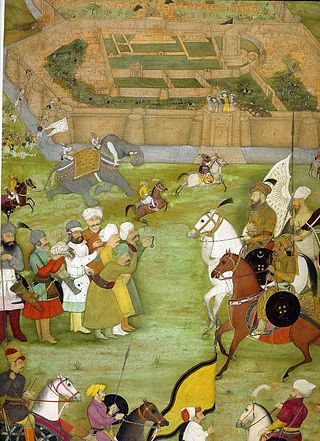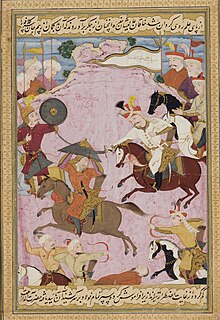
Babur was the founder of the Mughal Empire in the Indian subcontinent. He was a descendant of Timur and Genghis Khan through his father and mother respectively. He was also given the posthumous name of Firdaws Makani.

Ismail I was the founder and first shah of Safavid Iran, ruling from 1501 until his death in 1524. His reign is often considered the beginning of modern Iranian history, as well as one of the gunpowder empires. The rule of Ismail I is one of the most vital in the history of Iran. Before his accession in 1501, Iran, since its conquest by the Arabs eight-and-a-half centuries earlier, had not existed as a unified country under native Iranian rule. Although many Iranian dynasties rose to power amidst this whole period, it was only under the Buyids that a vast part of Iran properly returned to Iranian rule (945–1055).

The Timurid Empire was a late medieval, culturally Persianate Turco-Mongol empire that dominated Greater Iran in the early 15th century, comprising modern-day Iran, Iraq, Afghanistan, much of Central Asia, the South Caucasus, as well as parts of contemporary Pakistan, North India and Turkey. The empire was culturally hybrid, combining Turko-Mongolian and Persianate influences, with the last members of the dynasty being "regarded as ideal Perso-Islamic rulers".

The Registan was the heart of the city of Samarkand of the Timurid Empire, now in Uzbekistan. The name Rēgistan (ریگستان) means "sandy place" or "desert" in Persian.

Muhammad Shaybani Khan was an Uzbek leader who consolidated various Uzbek tribes and laid the foundations for their ascendance in Transoxiana and the establishment of the Khanate of Bukhara. He was a Shaybanid or descendant of Shiban, the fifth son of Jochi, Genghis Khan's eldest son. He was the son of Shah-Budag, thus a grandson of the Uzbek conqueror Abu'l-Khayr Khan.
Qasim bin Janibek Khan, known by his shortened regal name as Qasim Khan was a son of Janibek Khan. He ruled as the fourth Khan of the Kazakh Khanate from about 1511 to 1521. He is viewed as the greatest leader to unite the Kazakh tribes. Although, Burunduk Khan was the Khan of the Kazakhs, the control of the government was in the hands of Qasim Khan. Eventually, he sent Burunduk Khan into exile who died in Samarkand. Qasim Khan had a brother named Adik Khan who was married to Sultana Nigar Khanim, daughter of Yunus Khan of Moghulistan. When Adik Khan died, Qasim Khan took her as his wife.

Sultan Husayn Bayqara Mirza was the Timurid ruler of Herat from 1469 until May 4, 1506, with a brief interruption in 1470.

The Uzbek Khanate, also known as the Abulkhair Khanate was a Shaybanid state preceding the Khanate of Bukhara. During the few years it existed, the Uzbek Khanate was the preeminent state in Central Asia, ruling over most of modern-day Uzbekistan, much of Kazakhstan and Turkmenistan, and parts of southern Russia. This is the first state of the Abulkhairids, a branch of the Shaybanids.

The Khanate of Bukhara was an Uzbek state in Central Asia from 1501 to 1785, founded by the Abu'l-Khayrid dynasty, a branch of the Shaybanids. From 1533 to 1540, Bukhara briefly became its capital during the reign of Ubaydallah Khan. The Khanate reached its greatest extent and influence under its penultimate Abu'l-Khayrid ruler, the scholarly Abdullah Khan II.
The Arghun dynasty ruled over the area adjoining Southern Afghanistan and then the Sindh Sultanate from the late 15th century to the early 16th century. Arghun rule can be divided into two branches: the Arghun branch of Dhu'l-Nun Beg Arghun that ruled until 1554, and the Tarkhan branch of Muhammad Isa Tarkhan that ruled until 1593.

The Shibanids or Shaybanids or more accurately the Abu'l-Khayrid-Shibanids, were a dynasty of Turko-Mongol origin, who ruled over most of modern-day Kazakhstan, much of Uzbekistan, and parts of southern Russia in the 15th century. They were the patrilineal descendants of Shiban, the fifth son of Jochi and grandson of Genghis Khan. Until the mid-14th century, they acknowledged the authority of the descendants of Shiban's brothers Batu Khan and Orda Khan, such as Öz Beg Khan. The Shaybanids originally led the gray horde southeast of the Urals, and converted to Islam in 1282. At its height, the Khanate included parts of modern-day Afghanistan and other parts of Central Asia.

Ghiyath al-Din Muhammad, commonly known as Khvandamir was a Persian historian who was active in the Timurid, Safavid and Mughal empires. He is principally known for his Persian universal history, the Habib al-siyar, which was regarded by both the Safavids and Mughals as their first official court account.

The Battle of Merv occurred on 2 December 1510 as a result of the Uzbek invasion of the Khorasan region of Safavid Persia. It ended with a decisive victory for the Persians. The result was that the Safavids regained control of the Khorasan region.

Battle of Ab Darrah Pass was the battle that took place in 1511 in the place called Ab Darrah between Uzbeks and Babur of Timurids. The battle ended with the decisive Timurid victory which enabled Babur to regain Transoxiana and briefly reunite the whole of the ancestral part of the Timurid Empire. Such a decisive and significant battle is not mentioned in Babur’s Memoirs (Baburnama), in which there is a break from the year 1508 to the beginning of 1519.

Badi' al-Zaman Mirza was a Timurid ruler of Herat from 1506 to 1507. He was the son of Husayn Bayqarah, who was a great-great-grandson of Timur.

The foreign relations of the Mughal Empire were characterized by competition with the Persian Empire to the west, the Marathas and others to the south, and the British to the east. Steps were taken by successive Mughal rulers to secure the western frontiers of India. The Khyber Pass along the Kabul- Qandahar route was the natural defence for India, and their foreign policy revolved around securing these outposts, as also balancing the rise of powerful empires in the region. During the break up of the Timurid Empire in the 15th century, the Ottomans in Turkey, the Safavids in Persia and the Uzbegs in central Asia emerged as the new contenders of power. While the Safavids were Shia by faith, Ottomans along with Uzbegs were Sunni. The Mughals were also Sunni and Uzbegs were their natural enemies, who caused Babur and other Timurid princes to leave Khurasan and Samarqand. The powerful Uzbegs who held sway over central India sought an alliance of Sunni powers to defeat the Shia ruled Persia, but Mughals were too broadminded to be driven away by the sectarian conflicts. The Mughal rulers, especially Akbar, were keen to develop strong ties with Persia in order to balance the warring Uzbegs. Thus, the foreign policy of Mughals was centred around strengthening the ties with Persia, while maintaining the balance of power in the region by keeping a check on the evolution of a united Uzbeg empire.
The Kazakh War of Independence (1468–1500) was a conflict fought in Central Asia between the Kazakh Khanate and the Uzbek Khanate, which attempted to maintain its control over most of modern-day Kazakhstan, which at the time was under Uzbek rule. The war started after Abu'l-Khayr, Khan of the Uzbek Khanate, attacked Zhetysu in 1468 which was controlled by a small band of rebel Kazakhs who had split from the original Uzbek Khanate. Abu’l Khayr did so in an attempt to prevent the growing Kazakh influence among the steppe. However, he died unknowingly, making it easier for the Kazakhs to expand their influence. After Abu'l-Khayr Khan's death, the Uzbeks continued to be ruled by the Shaybanids who fought against the Kazakhs in the cities that were on the Syr Darya until both sides agreed to peace in 1500 with the Kazakh Khanate gaining its sovereignty from the Uzbek control. At the end of the war, the Uzbek Khanate transferred most of Kazakhstan to the Kazakh Khanate.
Ubaidullah Khan (1476–1539) was the 4th Shaybanid Khan of Bukhara, who ruled between 1534 and 1539. He was the son of Mahmud and nephew of Muhammad Shaybani, founder of the Shaybanid dynasty.














